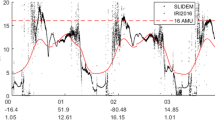Abstract
The Electric Field Instrument (EFI) was designed to measure ionospheric ion flow velocities, temperatures and distribution functions at the ram face of the European Space Agency’s Swarm spacecraft. These flow velocities, combined with the known orbital velocity of the satellite and local magnetic field, will be used to infer local electric fields from the relation E=−v×B. EFI is among a class of many particle sensors and flow meters mounted on satellites to monitor in situ plasma conditions. The interpretation of the measurements made with EFI and similar sensors relies on a spacecraft sheath model. A common approach, valid in the relatively cold and dense ionospheric plasma, is to assume a potential drop in a thin sheath through which particle deflection and energisation can be calculated analytically. In such models, sheath effects only depend on the spacecraft floating potential, and on the angle of incidence of particles with respect to the normal to the surface. Corrections to measurements are therefore local as they do not depend on the geometry of nearby objects. In an actual plasma, satellites are surrounded by electrostatic sheaths with a finite thickness. As a result, local corrections to particle distribution functions can only be seen as an approximation. A correct interpretation of measured particle fluxes or particle distribution functions must, at least in principle, account for the extent and shape of the sheath in the vicinity of the measuring instrument. This in turn requires a careful analysis of the interaction of the satellite with the surrounding plasma, while accounting for detailed aspects of the geometry, as well as for several physical effects. In this paper, the validity of the thin sheath model is tested by comparing its predictions with detailed PIC (Particle In Cell) calculations of satellite-plasma interaction. Deviations attributed to sheath finite thickness effects are calculated for EFI measurements, with representative plasma parameters encountered along the planned Swarm orbit. Finite thickness effects of the plasma sheaths are found to induce EFI velocity measurement errors not exceeding 37 m/s, with larger errors occurring in plasmas that are simultaneously tenuous (109 m−3 or lower) and warm (0.5 eV or higher).
Similar content being viewed by others
References
J.J. Berthelier, M. Godefroy, F. Leblanc, E. Seran, D. Peschard, P. Gilbert, J. Artru, IAP, the thermal plasma analyzer on DEMETER. Planet. Space Sci. 54, 487–501 (2006)
C. Carlson, J. McFadden, P. Turin, D. Curtis, A. Magoncelli, The electron and ion plasma experiment for FAST. Space Sci. Rev. 98(1–2), 33–66 (2001)
L.H. Fisher, R.N. Varney, Contact potentials between metals: history, concepts, and persistent misconceptions. Am. J. Phys. 44, 464–75 (1976)
E. Friis-Christensen, H. Lühr, D. Knudsen, R. Haagmans, Swarm—an earth observation mission investigating geospace. Adv. Space Res. 41, 210–216 (2008)
Y.I. Gal’perin, V.N. Ponomarev, Direct measurements of plasma convection in the upper ionosphere. Cosm. Res. 11(1), 79–84 (1973)
Y.I. Gal’perin, V.N. Ponomarev, A.G. Zosimova, Direct measurements of drift rate of ions in upper atmosphere during a magnetic storm. I. Problems of method and some results of measurements during magnetically quiet period. Cosm. Res. 11, 240–248 (1973a)
Y.I. Gal’Perin, V.N. Ponomarev, A.G. Zosimova, Direct measurements of drift rate of ions in upper atmosphere during a magnetic storm. II. Results of measurements during magnetic storm of November 3, 1967. Cosm. Res. 11, 249 (1973b)
Y.I. Gal’perin, V.N. Ponomarev, A.G. Zosimova, Plasma convection in the polar ionosphere. Ann. Geophys. 30, 1–7 (1975)
W.B. Hanson, R.A. Heelis, Techniques for measuring bulk gas motions from satellites. Space Sci. Instrum. 1, 493–524 (1975)
R.A. Heelis, W.B. Hanson, in Measurement Techniques in Space Plasmas: Particles, ed. by R.F. Pfaff, J.E. Borovsky, D.T. Young (Am. Geophys. Union, Washington, 1998), pp. 61–71
A. Hundhausen, J. Asbridge, S. Bame, H. Gilbert, I. Strong, Vela 3 satellite observations of solar wind ions: a preliminary report. J. Geophys. Res. 72(1), 87–100 (1967/01/01)
L.M. Kaiser, The stereo mission: an overview. Adv. Space Res. 36, 1483–1488 (2005)
D.J. Knudsen, J.K. Burchill, K. Berg, T. Cameron, G.A. Enno, C.G. Marcellus, E.P. King, I. Wevers, R.A. King, A low-energy charged particle distribution imager with a compact sensor for space applications. Rev. Sci. Instrum. 74, 202–211 (2003)
F. Mackay, R. Marchand, K. Kabin, Test-kinetic modelling of collisionless perpendicular shocks. J. Plasma Phys. 74, 301–18 (2008)
R. Marchand, Test-particle simulation of space plasmas. Commun. Comput. Phys. 8, 471–483 (2010)
R. Marchand, J.L.F. Mackay, K. Kabin, Consistency check of a global MHD simulation using the test-kinetic approach. Plasma Phys. Control. Fusion 50, 074007-110 (2008)
A. Nishida, The GEOTAIL mission. Geophys. Res. Lett. 21, 2871–2873 (1994)
K. Ogilvie, D. Chornay, R. Fritzenreiter, F. Hunsaker, J. Keller, J. Lobell, G. Miller, J. Scudder, J. Sittler E.C., R. Torbert, D. Bodet, G. Needell, A. Lazarus, J. Steinberg, J. Tappan, A. Mavretic, E. Gergin, SWE, a comprehensive plasma instrument for the wind spacecraft. Space Sci. Rev. 71(1–4), 55–77 (1995)
R. Pfaff, C. Carlson, J. Watzin, D. Everett, T. Gruner, An overview of the fast auroral snapshot (FAST) satellite. Space Sci. Rev. 98, 1–32 (2001)
A. Yau, H.G. James, W. Liu, The Canadian enhanced polar outflow probe (e-POP) mission in LWS. Adv. Space Res. 38, 1870–1877 (2006)
Author information
Authors and Affiliations
Corresponding author
Rights and permissions
About this article
Cite this article
Marchand, R., Burchill, J.K. & Knudsen, D.J. Modelling Electrostatic Sheath Effects on Swarm Electric Field Instrument Measurements. Space Sci Rev 156, 73–87 (2010). https://doi.org/10.1007/s11214-010-9735-y
Received:
Accepted:
Published:
Issue Date:
DOI: https://doi.org/10.1007/s11214-010-9735-y




